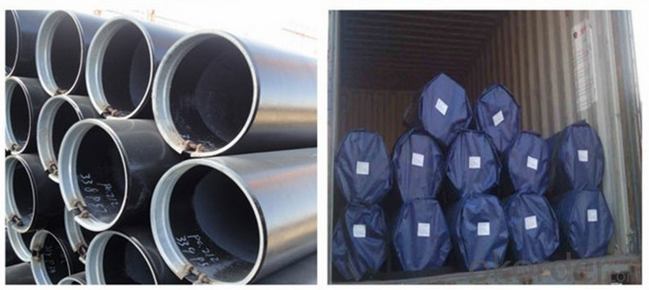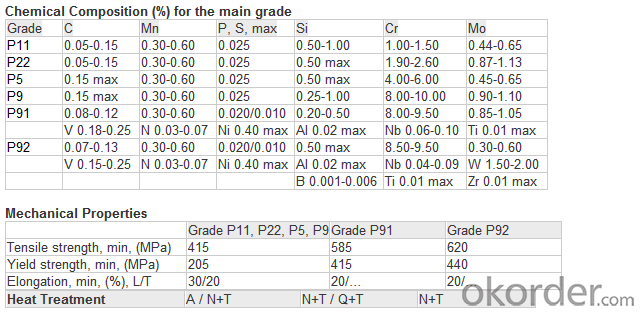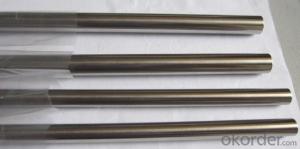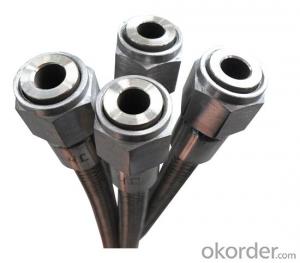stainless steel free cutting 303 stainless steel rods
- Loading Port:
- Shanghai
- Payment Terms:
- TT OR LC
- Min Order Qty:
- 1000 kg
- Supply Capability:
- 10000 kg/month
OKorder Service Pledge
OKorder Financial Service
You Might Also Like
Packaging Detail: | Bundle or Container or as per customers requirement. |
Delivery Detail: | within 25 days after we receive an irrevocable L/Cor 30% deposit |
ASTM A335 Seamless Alloy-Steel Pipe
Standard: BS 1139, BS 3059-2, JIS G3454-2007
Grade: 10#-45#, 15NiCuMoNb5, 10Cr9Mo1VNb
Detailed introduction to ASTM A335 seamless alloy steel pipe:
ASTM A335 seamless alloy steel pipe


FAQ:
1) why you chose us ?
Professional Manufacturer and supplier of Steel pipe
More than 14 years’ professional producing experience
We can get the lowest ex-factory prices. The price are quite reasonable and it is lower than our commercial peers. also, we can guarantee the qualities of our products.
BV, ISO certificates and SGS test can be provided to assure the quality of our products.
2) Our minimum order quantity:
10 Metric Tons or one 20ft or 40ft Container.
3) How about the Delivery Time?
The steel pipe will be produced since we getting your deposit by T/T or Your original L/C. For normal size, some stocks in our factory now, we can supply once you need.
4)What kind of payment does your company support?
T/T, 100% L/C at sight, Cash, Western Union are all accepted.
5) Do you charge for the samples?
According to our company principle, we just charge for samples, you pay for the freight /courier charge.
6) Main market:
Mid East, South America, Africa, Southeast Asia, India etc
- Q:Can stainless steel pipes be used for hydroelectric power plants?
- Hydroelectric power plants can indeed utilize stainless steel pipes. The reason stainless steel is favored for various industrial applications is because of its exceptional corrosion resistance. Within a hydroelectric power plant, the generation of electricity is achieved by the passage of water through turbines. The composition and flow rate of this water can often result in corrosive tendencies. Consequently, stainless steel pipes, which are highly resistant to corrosion, are the ideal conduit for conveying the water in hydroelectric power plants. Furthermore, stainless steel pipes bring forth additional advantages such as superior strength, durability, and the capacity to withstand elevated pressures and temperatures. These properties are vital for ensuring the efficient and dependable operation of the power plant. Moreover, stainless steel pipes maintain their structural integrity over time, thus reducing the need for frequent maintenance and replacement. In addition, stainless steel pipes possess the ability to handle the internal and external pressures that arise during the power generation process. They can effectively endure the high-speed flow of water and resist erosion caused by sediment and debris in the water supply. Consequently, the longevity and efficiency of the hydroelectric power plant are secured. To conclude, stainless steel pipes are an exceptional choice for hydroelectric power plants due to their corrosion resistance, strength, durability, and ability to withstand high pressures and temperatures.
- Q:Can stainless steel pipes be used for underground gas pipelines?
- Indeed, underground gas pipelines can utilize stainless steel pipes due to their remarkable resistance to corrosion. This characteristic renders stainless steel pipes exceptionally suitable for subterranean applications where exposure to moisture, soil, and other corrosive factors is inevitable. Moreover, stainless steel boasts outstanding mechanical properties, such as remarkable tensile strength and durability, which enable it to endure the demanding conditions and pressure prerequisites of gas pipelines below the surface. Furthermore, stainless steel pipes are renowned for their longevity and minimal maintenance needs, resulting in a cost-effective option for underground gas pipelines. Nevertheless, it is imperative to adhere to industry standards and regulations, as well as implement proper installation and maintenance methodologies, to guarantee the secure and efficient operation of gas pipelines.
- Q:What are the advantages of using stainless steel pipes in the oil and gas industry?
- There are several advantages of using stainless steel pipes in the oil and gas industry. Firstly, stainless steel pipes have excellent corrosion resistance, which makes them highly durable and reliable in harsh environments. This resistance to corrosion helps in preventing leaks and ensures the longevity of the pipes, reducing maintenance and replacement costs. Additionally, stainless steel pipes can withstand high temperatures and pressures, making them suitable for transporting oil and gas without the risk of failure. They also have excellent mechanical properties and are able to withstand impacts and vibrations, ensuring the integrity of the pipelines. Furthermore, stainless steel pipes have good hygiene properties, as they are resistant to bacteria and can be easily cleaned, which is crucial in industries where contamination is a concern. Overall, the use of stainless steel pipes in the oil and gas industry offers increased safety, cost-effectiveness, and reliability.
- Q:What are the common sizes of stainless steel pipes used in construction?
- The specific application and requirements determine the varying common sizes of stainless steel pipes used in construction. However, numerous construction projects commonly utilize a few standard sizes. These sizes encompass 1/2 inch, 3/4 inch, 1 inch, 1.5 inches, 2 inches, 3 inches, 4 inches, 6 inches, and 8 inches. Distinct purposes are associated with these sizes. For plumbing and water supply systems in residential and commercial buildings, smaller sizes like 1/2 inch, 3/4 inch, and 1 inch are frequently employed. They are also applicable for gas lines and ventilation systems. Larger sizes like 1.5 inches, 2 inches, 3 inches, and 4 inches are predominantly utilized in industrial contexts, including oil and gas pipelines, chemical processing plants, and power generation facilities. These pipes are engineered to accommodate higher flow rates and pressure demands. Moreover, even larger sizes like 6 inches and 8 inches find utility in specialized applications, such as large-scale industrial projects and infrastructure development. Water treatment plants, wastewater treatment facilities, and large-scale irrigation systems often employ these sizes. It is vital to acknowledge that these common sizes represent only a portion of the available options, as numerous other sizes are contingent upon the specific requirements of a construction project. Consultation with a professional engineer or contractor is always advisable to determine the appropriate size of stainless steel pipes for a particular construction endeavor.
- Q:What are the different finishes available for stainless steel pipes?
- Stainless steel pipes come in various finishes, each offering a distinct appearance and level of protection against corrosion. 1. Brushed Finish: By utilizing a fine abrasive material, the surface of the stainless steel pipe is brushed to create a textured and dull look. This finish effectively conceals scratches and fingerprints, making it a popular choice for projects that prioritize aesthetics, such as architectural designs. 2. Mirror Finish: Also referred to as a polished or reflective finish, this option involves polishing the surface of the stainless steel pipe to achieve a highly reflective shine. It provides a smooth and easily cleanable surface, commonly used for decorative purposes like handrails and furniture. 3. Satin Finish: Similar to the brushed finish, the satin finish employs a fine abrasive material to create a smooth and dull appearance. It offers a slightly more refined look compared to the brushed finish and is frequently utilized in applications where corrosion resistance is crucial, such as the food and beverage industry. 4. Embossed Finish: This finish entails imprinting a pattern onto the surface of the stainless steel pipe, adding texture and visual interest. It is often employed in decorative applications like wall panels or elevator interiors. 5. Bead Blasted Finish: Achieved by propelling small glass beads at high pressure onto the stainless steel pipe's surface, this finish creates a uniform and matte appearance. It is commonly used in architectural projects as it provides a unique texture and effectively conceals fingerprints. 6. Passivated Finish: The passivation process involves chemically removing contaminants from the surface of the stainless steel pipe to enhance its corrosion resistance. This finish is frequently employed in applications where the pipes are exposed to harsh environments or chemicals. It is crucial to consider the specific application and aesthetic preferences when selecting a finish for stainless steel pipes. Each finish has its own pros and cons, so factors like durability, maintenance, and the intended use of the pipe should be taken into account before making a decision.
- Q:Can stainless steel pipes be surface treated?
- Yes, stainless steel pipes can be surface treated. Surface treatment is often done to improve the aesthetics, corrosion resistance, and durability of stainless steel pipes. Common surface treatment methods for stainless steel pipes include passivation, electropolishing, pickling, and applying various coatings. Passivation involves the removal of impurities from the surface of the stainless steel, creating a protective oxide layer that enhances corrosion resistance. Electropolishing is an electrochemical process that smooths and polishes the surface of stainless steel pipes, improving their appearance and reducing the likelihood of bacterial growth. Pickling involves the removal of scale and oxide layers from the surface by using acid solutions. Coatings such as powder coating, paint, or plating can also be applied to stainless steel pipes to provide additional protection against corrosion, enhance appearance, or meet specific requirements. Overall, surface treatment options for stainless steel pipes are diverse and can be tailored to meet the desired functional and aesthetic needs.
- Q:Why can stainless steel pipes be welded by argon arc welding?
- Argon arc welding arc welding, convenient operation and observation; electrode loss is small, easy to maintain the arc length, welding flux free, coating layer, so it is easy to realize mechanization and automation; argon arc welding welding can almost all metals, especially some refractory metal, oxidizable metals, such as magnesium, titanium, molybdenum zirconium and aluminum and its alloys; by the welding location restrictions, can be used for all position welding.
- Q:Can stainless steel pipes be used for brewery and beverage industry applications?
- Yes, stainless steel pipes can be used for brewery and beverage industry applications. Stainless steel is widely recognized for its excellent corrosion resistance and hygienic properties, making it an ideal material choice for these industries. The high levels of chromium and nickel present in stainless steel pipes provide superior resistance to corrosion from chemicals, acids, and high-temperature environments. Additionally, stainless steel pipes are easy to clean and maintain, ensuring the highest level of hygiene required in brewery and beverage production. The smooth internal surface of stainless steel pipes also minimizes the risk of contamination and bacterial growth, further enhancing its suitability for these applications. Overall, stainless steel pipes offer durability, reliability, and sanitary features that make them a preferred choice for use in the brewery and beverage industry.
- Q:What are the maintenance requirements for stainless steel pipes?
- The maintenance requirements for stainless steel pipes are relatively low compared to other materials. However, there are a few key steps that should be taken to ensure their longevity and optimal performance. Firstly, regular cleaning is essential to remove any dirt, grime, or other contaminants that may accumulate on the surface of the pipes. This can be done using mild soap and water or a non-abrasive cleaner. It is important to avoid using abrasive materials or harsh chemicals as they can damage the stainless steel surface. Secondly, it is recommended to inspect the pipes periodically to check for any signs of corrosion or damage. Stainless steel is known for its resistance to corrosion, but in certain environments or under specific conditions, it can still be susceptible to corrosion. Any signs of corrosion should be addressed promptly to prevent further deterioration. Thirdly, stainless steel pipes should be protected from physical damage or impact. This can be achieved by avoiding heavy objects from hitting or rubbing against the pipes, as well as using appropriate padding or insulation in areas where they are exposed to potential impact. Lastly, it is important to ensure that stainless steel pipes are installed and used in accordance with their intended purpose and within their specified temperature and pressure limits. This will help prevent any undue stress or strain on the pipes, which could lead to premature failure. Overall, by following these maintenance requirements, stainless steel pipes can provide long-lasting durability and performance in a wide range of applications.
- Q:Can stainless steel pipes be used for dairy processing plants?
- Yes, stainless steel pipes are commonly used in dairy processing plants due to their hygienic properties, corrosion resistance, and ease of cleaning.
1. Manufacturer Overview |
|
|---|---|
| Location | |
| Year Established | |
| Annual Output Value | |
| Main Markets | |
| Company Certifications | |
2. Manufacturer Certificates |
|
|---|---|
| a) Certification Name | |
| Range | |
| Reference | |
| Validity Period | |
3. Manufacturer Capability |
|
|---|---|
| a)Trade Capacity | |
| Nearest Port | |
| Export Percentage | |
| No.of Employees in Trade Department | |
| Language Spoken: | |
| b)Factory Information | |
| Factory Size: | |
| No. of Production Lines | |
| Contract Manufacturing | |
| Product Price Range | |
Send your message to us
stainless steel free cutting 303 stainless steel rods
- Loading Port:
- Shanghai
- Payment Terms:
- TT OR LC
- Min Order Qty:
- 1000 kg
- Supply Capability:
- 10000 kg/month
OKorder Service Pledge
OKorder Financial Service
Similar products
New products
Hot products
Hot Searches
Related keywords


































